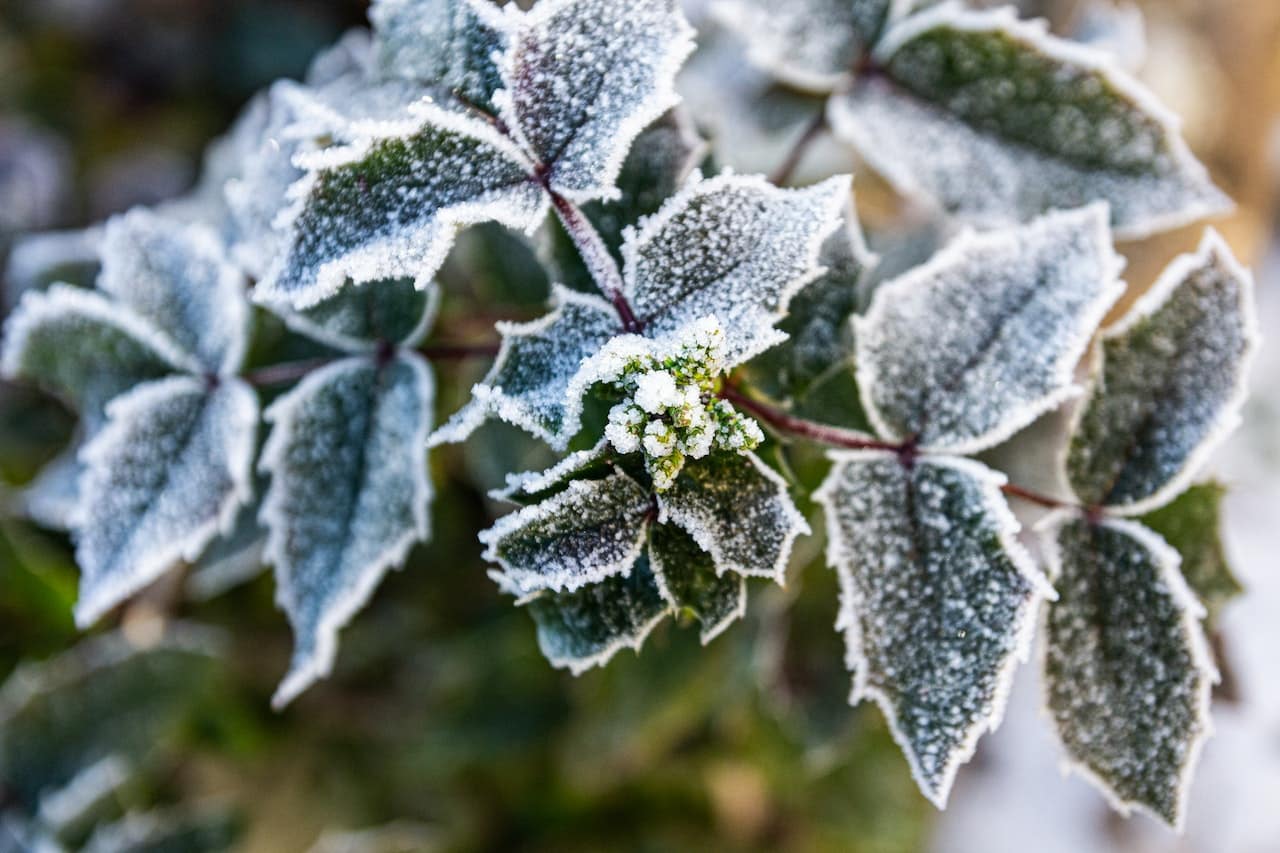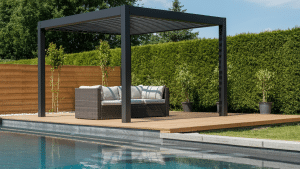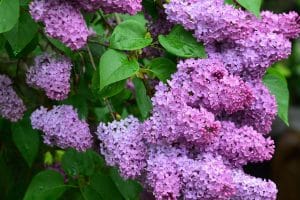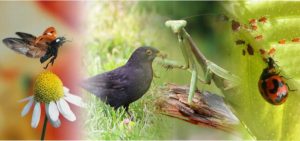The leaves are off the trees, warm season grasses have gone dormant. Spring bulbs are planted. It may seem like all of your landscape tasks are complete for the year. However, if you want to put your best gardening foot forward next spring, consider winter pruning. Pruning flowering shrubs and fruiting trees is essential to ensure vigorous production next season.
But what should you prune, and when is the best time to do it? Can improper pruning damage your landscape? And what are the most effective techniques?
These are common questions. Unfortunately, improper pruning, or pruning at the wrong time of year, can result in misshapen plants, or reduced flowering and fruiting. It can also cause your plants to be more susceptible to damage from disease, insects, and freezing temperatures. But don’t worry. We’ve put together a handy guide for proper pruning of your winter landscape. This will help ensure a healthy, colorful garden in the spring.
Pruning Tools
To do any task correctly, you have to have the right tools. Most pruning tasks can be accomplished by home gardeners using hand pruners, lopping shears, pruning saws, pole pruners, and hedge shears.
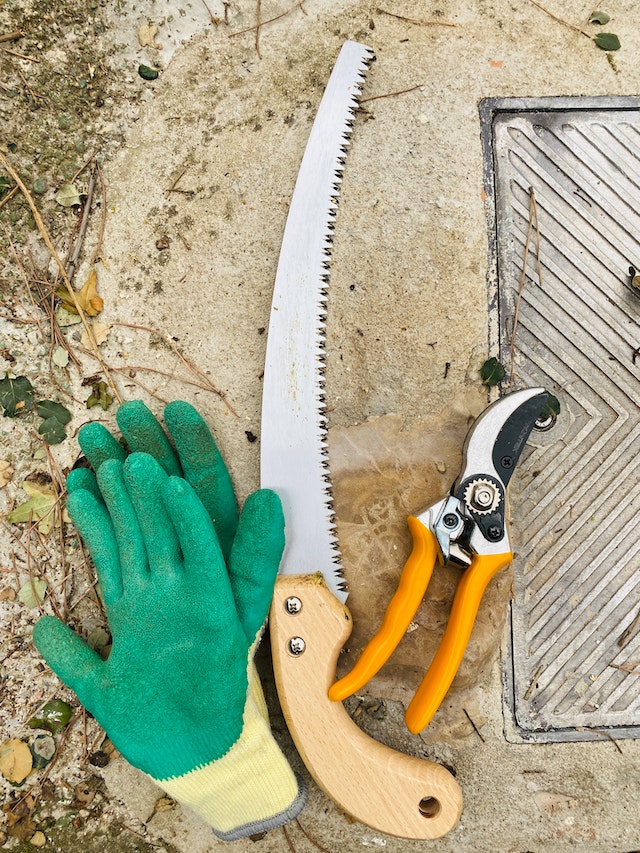
When shopping for tools, be sure to look for quality and durability. Proper maintenance and the ability to procure replacement parts is also important. Cutting and sawing through wood tends to dull blades quickly.
- Hand Pruners: These small pruners come in draw cut or snap cut varieties. The snap cut pruners can more easily cut small twigs and branches up to 0.5 inches. The draw cut variety makes closer, smoother cuts.
- Lopping Shears: Utilizing a scissor-like action, these handheld shears have longer handles and larger blades. This allows for pruning branches of up to 1.5 inches in one stroke while requiring minimum hand strength.
- Pruning Saws: Using a narrow, curved, coarse-toothed blade, this handheld saw cuts branches larger than 1.5 inches in diameter.
- Pole Pruners: Available in manual, gas- and battery-powered varieties, this “saw on a stick” is used for pruning branches that cannot be reached from the ground.
- Hedge Shears: Also available in manual, gas- and battery-powered varieties, these shears are used mainly on dense shrubs to achieve a uniform, manicured appearance.
Pruning Techniques
Pruning involves removing buds at the end of a twig/branch in order to encourage new, vigorous growth. There are several different pruning techniques. It’s important to select the right technique depending upon the type of plant, as well as your objective.
- Shearing: This technique removes just the new growth from the outside of the plant. It changes the shrub’s natural shape into one of the gardener’s choosing (e.g. boxwood hedges or topiaries.)
- Thinning: This technique cuts selected branches back to the main trunk. Thinning allows sunlight to reach the interior portion of the plant, encouraging growth for a fuller, more attractive appearance.
Where Should I Cut?
In order to avoid stubby or misshapen plants, it’s important to know where to make your cut. Let’s go over the terms:
- Trunk: The main wooden axis of the plant or tree.
- Lateral Branch: A branch that grows outward from the trunk, or along the length of another, larger branch.
- Bud: A small growth along a branch or twig that develops into a leaf, shoot, or bloom.
When pruning, you shouldn’t leave stubs. Not only are they unattractive, but they can damage your plant. Avoid stubs by pruning back to a bud (a), a lateral branch (b), or to the main trunk (c) itself.
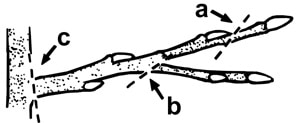
With larger branches, you can avoid damaging the bark on the trunk by executing a jump cut. This involves making three separate cuts.
- From the bottom, cut about halfway through a branch or limb about a foot from the main trunk.
- Make a second cut on top of the same limb a few inches further out than the first cut.
- Cut the remaining stub back to the branch collar, which is the thicker area where the branch meets the main trunk.
Renewal Pruning for Overgrown Shrubs
We’ve all seen houses with out-of-control foundation shrubs. When improperly selected and maintained, foundation plantings can obscure windows, crowd out other plants, and make your landscape look unkempt. Cutting these shrubs back severely (to a height of about 12 inches above ground) can help restore order to your landscape.
However, knowing what and when to prune is important for optimal results.
Most broadleaf plants respond well to renewal pruning:
- Azalea
- Camellia
- Abelia
- Crape Myrtle
- Gardenia
Narrow-leaf evergreens do not respond as well to renewal pruning:
- Juniper
- Pine
- Cypress
- Arborvitae
- Boxwood
As an alternative to renewal pruning, consider transplanting or skirting. Skirting involves removing low-growing branches in order to increase light and visibility.
When Should I Prune?
Perhaps the most important aspect of effective pruning is timing. Pruning at the wrong time can remove fall-set buds, meaning fewer flowers in the spring.
Many people ask about pruning hydrangeas in winter. The answer is no! Smooth hydrangea and oakleaf hydrangea bloom on old wood.
Plants that bloom in spring and early summer should be pruned after they bloom. This avoids removing next season’s buds. These include:
- Azaleas
- Bradford Pear
- Crabapple
- Climbing Rose
- Dogwood
- Forsythia
- Flowering Cherry
- Weigelia
- Mockorange
- Lilac
- Wisteria
- Magnolia Star
Another common question regards pruning roses for winter. The perfect time to prune dormant bush-type roses is late winter or very early spring, just before new growth begins. Pruning hardy hibiscus for winter includes rose of sharon and rose mallow, or swamp hibiscus. Limit pruning perennial hibiscus plants to what is needed to shape or control their size.
When it comes to pruning apple trees in winter, we recommend waiting until the leaves have fallen off. This means the tree is dormant. It’s also important to avoid pruning fruit spurs. These are the short stems which will produce fruit in summer.
In general, pruning fruit trees in winter helps fruit production, and maintains their shape and vigor.
Winter pruning also works best for the following:
Camellia
- Crape Myrtle
- Fragrant Tea Olive
- Barberry
- Mimosa
- Glossy Abelia
- Spirea
- Peach Trees
- Pear Trees
- Muscadines
- Blueberry Bushes
Renewal Pruning: Late winter (mid-March) is the best time to undertake severe pruning in the Atlanta area. This helps avoid frost damage. Abundant new growth should be apparent by mid-summer.
If you have additional questions about pruning, or would like to schedule service, contact Oasis Landscapes & Irrigation at (770) 913-9033. We’re always happy to help!

